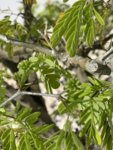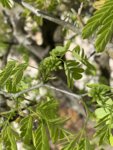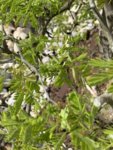You are using an out of date browser. It may not display this or other websites correctly.
You should upgrade or use an alternative browser.
You should upgrade or use an alternative browser.
Brazilian Rain Tree help needed
- Thread starter janaiya
- Start date
Leo in N E Illinois
The Professor
- Messages
- 11,502
- Reaction score
- 23,873
- USDA Zone
- 5b
The potting mix from Weigert's looks great, very similar to a mix I use. This is the mix I would use. This is open enough that you would probably need daily, or every other day watering. It is open enough that even if the soil is still moist you can water without causing the tree to be over watered. It will allow air to penetrate even when wet.
The potting mix from Tropical Bonsai Miami has too many fine particles in it. It would likely hold enough water that your tree would not need water more than once every 3 to 7 days depending on temperature, sun and wind. I would not use this mix. Or if you want to ''salvage'' this mix, you must use a sieve and remove the fine particles. The fine particles are blocking the movement of air to the roots. Use a piece of window screen, ( roughly 1/16th inch mesh ) and shake small portions of this mix on top of the window screen. Throw out anything that goes through the screen. This will improve the Tropical Bonsai Miami mix. They probably use this mix because they can get away with watering only once or twice a week. When you have to pay someone to water, if you can skip a few days, you save money. So that is probably why they use this mix, it lets them reduce labor costs.
If you know you will be traveling, and can not have yourself or someone check your tree for water daily, you can use the heavy water holding mix, if you can figure out when to water. Once you know the patter (use your finger, or the bamboo skewer, or the moisture meter) you can then take your long weekend without worrying that the tree will dry out totally in your absence. But personally I would just use the Weigert's mix.
The potting mix from Tropical Bonsai Miami has too many fine particles in it. It would likely hold enough water that your tree would not need water more than once every 3 to 7 days depending on temperature, sun and wind. I would not use this mix. Or if you want to ''salvage'' this mix, you must use a sieve and remove the fine particles. The fine particles are blocking the movement of air to the roots. Use a piece of window screen, ( roughly 1/16th inch mesh ) and shake small portions of this mix on top of the window screen. Throw out anything that goes through the screen. This will improve the Tropical Bonsai Miami mix. They probably use this mix because they can get away with watering only once or twice a week. When you have to pay someone to water, if you can skip a few days, you save money. So that is probably why they use this mix, it lets them reduce labor costs.
If you know you will be traveling, and can not have yourself or someone check your tree for water daily, you can use the heavy water holding mix, if you can figure out when to water. Once you know the patter (use your finger, or the bamboo skewer, or the moisture meter) you can then take your long weekend without worrying that the tree will dry out totally in your absence. But personally I would just use the Weigert's mix.
janaiya
Yamadori
I am really glad I got that bonsai mix from Wigert's, first of all their Bonsai just look amazing and that's the bonsai mix I saw in all his finished and trained bonsai. And they told me to use it for those to BRT's.
Also all the info I got from online research 90% using the granular mix and you can see how happy those bonsai are. Instead where we got our big BRT I have not seen them using it all. I get it that it is to save labor, and on top it does look better than granular. I was not particular impressed by their developed bonsai either (online) and of course I was not happy with the bonsai my son bought there because he already had those bright greenish leaves when he arrived. Don't give me wrong they have some great bonsai but I was not able to get that harmony and energy I felt just looking at Eric Wigert's work.
So I will probably use that bonsai mix in our garden and other plants.
Thanks for the tips about traveling, we have not thought about that. But I know we will never all go together, one will always be at home. And than I have our green thumb neighbor or I can bring them to Wigert's, they offer a reasonable service for those moments and take care of them.
Do you have ever used mycelium on your bonsai? I was thinking to try it out to give the BRT the strength he obviously does not have. Not sure if I can use it in "Florida Winter"?
Leo, your expertise is very valuable to me, thank you again for sharing. I might be knocking at your door for some future questions hope you don't mind?
Also all the info I got from online research 90% using the granular mix and you can see how happy those bonsai are. Instead where we got our big BRT I have not seen them using it all. I get it that it is to save labor, and on top it does look better than granular. I was not particular impressed by their developed bonsai either (online) and of course I was not happy with the bonsai my son bought there because he already had those bright greenish leaves when he arrived. Don't give me wrong they have some great bonsai but I was not able to get that harmony and energy I felt just looking at Eric Wigert's work.
So I will probably use that bonsai mix in our garden and other plants.
Thanks for the tips about traveling, we have not thought about that. But I know we will never all go together, one will always be at home. And than I have our green thumb neighbor or I can bring them to Wigert's, they offer a reasonable service for those moments and take care of them.
Do you have ever used mycelium on your bonsai? I was thinking to try it out to give the BRT the strength he obviously does not have. Not sure if I can use it in "Florida Winter"?
Leo, your expertise is very valuable to me, thank you again for sharing. I might be knocking at your door for some future questions hope you don't mind?
janaiya
Yamadori
Thanks for your links, love to see other members BRT's and their experiences.
janaiya
Yamadori
I have good news today. Our Brt looks already so much better. Most of the yellow leaves have fallen and still falling and new nice green leaves have taken their spot. WOW, this tree regenerates his foliage really fast. So we are learning that this Brt living here in S Florida is in need of water and not vice versa. Of course depending on the weather what atm is hot in the sun and cools nicely down in the evening, but its not cold. And depending on the soil it is in. So I think we are figuring out when to water and when not.
And voila .... today I spotted 3 blooms what are about to open, this tells me that he is doing really good so far and his strength is more powerful than thought.
And voila .... today I spotted 3 blooms what are about to open, this tells me that he is doing really good so far and his strength is more powerful than thought.
Attachments
-
 32EA2850-B837-42EF-B36E-B2F3123FE36D.jpeg187.3 KB · Views: 33
32EA2850-B837-42EF-B36E-B2F3123FE36D.jpeg187.3 KB · Views: 33 -
 E4499BD7-BA04-41AD-A0C5-2819B918B3C9.jpeg186.9 KB · Views: 32
E4499BD7-BA04-41AD-A0C5-2819B918B3C9.jpeg186.9 KB · Views: 32 -
 C4EAD952-ADC1-466D-AC87-450286BCE202.jpeg214.6 KB · Views: 37
C4EAD952-ADC1-466D-AC87-450286BCE202.jpeg214.6 KB · Views: 37 -
 79394C5A-9365-45B4-9F82-43D1A5B6950A.jpeg288.6 KB · Views: 39
79394C5A-9365-45B4-9F82-43D1A5B6950A.jpeg288.6 KB · Views: 39 -
 D652F9EB-8A6D-4F58-82A2-57788D273DC6.jpeg288.1 KB · Views: 47
D652F9EB-8A6D-4F58-82A2-57788D273DC6.jpeg288.1 KB · Views: 47
janaiya
Yamadori
And here my smaller one what really never reacted with Stress symptoms when I relocated him with a 3 hrs ride from West to the East coast. I am happy!! Maybe it’s still coming. I hope not.
I would like some ideas where I should put my focus on in a few month. I don’t like the straight up trunk too much and need to balance that with the right thick branch,
What should I do with the top? I like a more flat top . What you guys think? Any ideas are welcome
I would like some ideas where I should put my focus on in a few month. I don’t like the straight up trunk too much and need to balance that with the right thick branch,
What should I do with the top? I like a more flat top . What you guys think? Any ideas are welcome
Attachments
Last edited:
janaiya
Yamadori
View attachment 223486
Now that's a beauty.
Thank you. Lots to do on it in the upcoming growing season. I also have to figure out his front side. And I am not seeing him good balanced but for now I am happy he likes it here!
janaiya
Yamadori
I wanted to post some updates. Pictures say more I guess.
Now my BRT is blooming and today opened his first flower of the whole bloom.
I am so happy to see him flowering, and the flower is really beautiful and so tiny.
I guess its a good sign that he is happy. Is it good to have him blooming or its not that good for the tree? Somewhere
I read that they pinch off the blooms. Why is that? I think we should him let do what he feels like doing, I believe its a sign of happiness and love and looks very graceful.
Btw he has still yellow old leaves what I am about to take off to facilitate the new ones. Its actually very easy to spot the old leaves what he is about to drop. Everything I do is helping him in the process.
We put him also back in the soil surrounded by big stones and underneath as well to facilitate airflow and drainage. Its going pretty good for now



Now my BRT is blooming and today opened his first flower of the whole bloom.
I am so happy to see him flowering, and the flower is really beautiful and so tiny.
I guess its a good sign that he is happy. Is it good to have him blooming or its not that good for the tree? Somewhere
I read that they pinch off the blooms. Why is that? I think we should him let do what he feels like doing, I believe its a sign of happiness and love and looks very graceful.
Btw he has still yellow old leaves what I am about to take off to facilitate the new ones. Its actually very easy to spot the old leaves what he is about to drop. Everything I do is helping him in the process.
We put him also back in the soil surrounded by big stones and underneath as well to facilitate airflow and drainage. Its going pretty good for now



janaiya
Yamadori
I have an update. I have spiderwebs on my BRT. And they must have been there for quite a while and I think they are the whole problem from the beginning. Going through my past pics I found 1 pic you can actually see 1 spiderweb, not the mites .
Now I sprayed him in the evening with Neem oil mixed in water and soap and sprayed the tree 3 days in a row because each next day I found another spiderweb. For now they seem to be gone, but the foliage does not look that good and I am pretty sure they will be all gone soon. There are also a few branches without any leaves for quite some time and nothing grows back there. What should I do? Cut the branch a little shorter to see if its still green inside to give him a boost to grow or let it be?
Now I sprayed him in the evening with Neem oil mixed in water and soap and sprayed the tree 3 days in a row because each next day I found another spiderweb. For now they seem to be gone, but the foliage does not look that good and I am pretty sure they will be all gone soon. There are also a few branches without any leaves for quite some time and nothing grows back there. What should I do? Cut the branch a little shorter to see if its still green inside to give him a boost to grow or let it be?
Frojo
Sapling
Spiders are predators and eat insects. They are good and cannot harm a tree.
janaiya
Yamadori
what about spider mites? Maybe that's what I meant.
Timber
Sapling
Stuck inside with winter blues, staring out the window patiently waiting for spring.Thanks for your links, love to see other members BRT's and their experiences.
Attachments
shinmai
Chumono
The thing about spider mites is that they are not spiders. If you see webbing that is like a ‘classical’ spider web, you have a spider, which as was mentioned earlier is not a bad thing. A true spider will regard mites as an attractive dinner buffet.
Spider mites are generally on the more tender undersides of leaves. They get the ‘spider’ part of their name because they can produce a silk-like material, but if present it is usually a blurry, amorphous mess rather than an organized web.
Spider mites can also be almost too small to see easily. One way to detect is to hold a sheet of white paper under some branches and shake or jostle them—the mites will fall off and be visible.
They have a very short reproductive cycle, so whatever you use, do so every other day for at least a week. Neem oil works pretty well, but insecticidal soap is better [though it also kills predator mites, but those are not very common]. Using chemical insecticides or miticides can rather easily develop your own little resistant population because of the multiple reproductive forms present at one time.
I know that you have only a couple of trees or so, but generally for situations with multiple trees it’s always a good idea to isolate a tree with any sort of infestation while you’re dealing with it.
Spider mites are generally on the more tender undersides of leaves. They get the ‘spider’ part of their name because they can produce a silk-like material, but if present it is usually a blurry, amorphous mess rather than an organized web.
Spider mites can also be almost too small to see easily. One way to detect is to hold a sheet of white paper under some branches and shake or jostle them—the mites will fall off and be visible.
They have a very short reproductive cycle, so whatever you use, do so every other day for at least a week. Neem oil works pretty well, but insecticidal soap is better [though it also kills predator mites, but those are not very common]. Using chemical insecticides or miticides can rather easily develop your own little resistant population because of the multiple reproductive forms present at one time.
I know that you have only a couple of trees or so, but generally for situations with multiple trees it’s always a good idea to isolate a tree with any sort of infestation while you’re dealing with it.
janaiya
Yamadori
The thing about spider mites is that they are not spiders. If you see webbing that is like a ‘classical’ spider web, you have a spider, which as was mentioned earlier is not a bad thing. A true spider will regard mites as an attractive dinner buffet.
Spider mites are generally on the more tender undersides of leaves. They get the ‘spider’ part of their name because they can produce a silk-like material, but if present it is usually a blurry, amorphous mess rather than an organized web.
Spider mites can also be almost too small to see easily. One way to detect is to hold a sheet of white paper under some branches and shake or jostle them—the mites will fall off and be visible.
They have a very short reproductive cycle, so whatever you use, do so every other day for at least a week. Neem oil works pretty well, but insecticidal soap is better [though it also kills predator mites, but those are not very common]. Using chemical insecticides or miticides can rather easily develop your own little resistant population because of the multiple reproductive forms present at one time.
I know that you have only a couple of trees or so, but generally for situations with multiple trees it’s always a good idea to isolate a tree with any sort of infestation while you’re dealing with it.
Thank you for those details, I will do that next morning and try it out. Does not mean I might find any but you never know.
Plants close I sprayed as well, just to make sure.
I am against chemicals in general, but if I don’t know what it is and if it’s insects or fungus I will probably have to do it.
But afraid for my dog who can get in touch with it.
LanceMac10
Imperial Masterpiece
shinmai
Chumono
To paraphrase Larry the Cable Guy, “That was damn funny, I don’t care who you are!”
I heard recently that the good news is that if you play the most recent Green Day album backwards, you can hear the voice of Satan. The bad news is that if you play it forward, you hear the new Green Day album.
I heard recently that the good news is that if you play the most recent Green Day album backwards, you can hear the voice of Satan. The bad news is that if you play it forward, you hear the new Green Day album.
LanceMac10
Imperial Masterpiece
janaiya
Yamadori
Similar threads
- Replies
- 12
- Views
- 691








